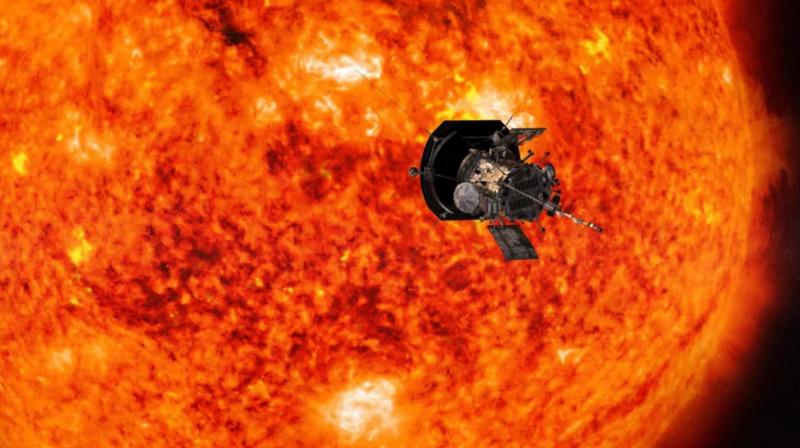
Christmas Eve Fly-By Could Unlock Secrets of Our Star
NASA Parker Solar Probe Sun Mission: A NASA spacecraft is attempting an unprecedented feat: making the closest-ever approach to the Sun. The Parker Solar Probe, launched in 2018, is diving into the Sun’s outer atmosphere, known as the corona, enduring searing temperatures and intense radiation in its quest to unravel the mysteries of our star.
Pushing the Limits
The probe’s daring maneuver on Christmas Eve brings it within 3.8 million miles (6.2 million kilometers) of the Sun’s surface. To put that in perspective, while Earth is 93 million miles away from the Sun, NASA’s Nicola Fox explains, “If the Sun and Earth were one meter apart, Parker Solar Probe would be just four centimeters from the Sun.”
At this proximity, the spacecraft must withstand blistering temperatures of 1,400°C (2,552°F) and radiation levels that could fry most electronics. Protected by a carbon-composite shield just 4.5 inches (11.5 cm) thick, the probe’s strategy is to plunge in and out of the Sun’s corona at record speeds, traveling at 430,000 mph (700,000 km/h). This is faster than any human-made object, equivalent to a flight from London to New York in less than 30 seconds.
Unlocking Solar Mysteries
The Parker Solar Probe aims to answer some of the most enduring questions about the Sun. One of the biggest mysteries concerns the temperature of the corona, which reaches millions of degrees—much hotter than the Sun’s surface, which is about 6,000°C (10,832°F).
“The corona is really, really hot, and we have no idea why,” says Dr. Jenifer Millard, an astronomer at Fifth Star Labs in Wales. The mission could provide insights into why this outer atmosphere is significantly hotter despite being farther from the Sun’s core.
Additionally, the probe is expected to enhance our understanding of the solar wind, a stream of charged particles constantly emitted by the Sun. These particles interact with Earth’s magnetic field, producing dazzling auroras but also posing risks such as power grid disruptions and communication failures.
“Understanding the Sun, its activity, and space weather is crucial to our everyday lives on Earth,” adds Dr. Millard.
Anxious Wait for Results
During this fly-by, the Parker Solar Probe will be out of communication with Earth for several days due to the Sun’s overwhelming radiation and heat. NASA scientists anticipate a signal on December 27, which will confirm whether the probe has survived its perilous journey.
Dr. Nicola Fox, NASA’s head of science, admits to feeling nervous but remains optimistic. “We’ve designed the probe to withstand these brutal conditions. It’s a tough, tough little spacecraft,” she says.
The team has a simple plan to notify Dr. Fox of the probe’s status: a green heart emoji text message will confirm that the spacecraft is safe and operational. (NASA Sun Mission)
A Historic Mission
This latest fly-by marks the Parker Solar Probe’s 22nd encounter with the Sun, each journey bringing it closer to unlocking the secrets of our solar system’s central star. If successful, the data collected could transform our understanding of solar physics, offering invaluable knowledge about the Sun’s influence on Earth and beyond. (NASA Sun Mission)
For now, all eyes are on December 27, as the world awaits news of the spacecraft’s fate and the potential revelations it carries from the heart of our solar system.
(For more news apart from NASA Parker Solar Probe Sun Mission, stay tuned to Rozana Spokesman)













